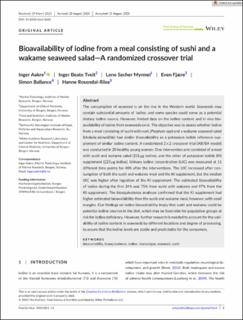| dc.contributor.author | Aakre, Inger | |
| dc.contributor.author | Tveit, Inger Beate | |
| dc.contributor.author | Myrmel, Lene Secher | |
| dc.contributor.author | Fjære, Even | |
| dc.contributor.author | Ballance, Simon | |
| dc.contributor.author | Rosendahl-Riise, Hanne | |
| dc.date.accessioned | 2023-09-29T11:27:59Z | |
| dc.date.available | 2023-09-29T11:27:59Z | |
| dc.date.created | 2023-09-25T13:36:15Z | |
| dc.date.issued | 2023 | |
| dc.identifier.issn | 2048-7177 | |
| dc.identifier.uri | https://hdl.handle.net/11250/3093098 | |
| dc.description.abstract | The consumption of seaweed is on the rise in the Western world. Seaweeds may contain substantial amounts of iodine, and some species could serve as a potential dietary iodine source. However, limited data on the iodine content and in vivo bioavailability of iodine from seaweeds exist. The objective was to assess whether iodine from a meal consisting of sushi with nori, (Porphyra spp) and a wakame seaweed salad (Undaria pinnatifida) had similar bioavailability as a potassium iodide reference supplement of similar iodine content. A randomized 2 × 2 crossover trial (AB/BA model) was conducted in 20 healthy young women. One intervention arm consisted of a meal with sushi and wakame salad (231 μg iodine), and the other of potassium iodide (KI) supplement (225 μg iodine). Urinary iodine concentration (UIC) was measured at 11 different time points for 48 h after the interventions. The UIC increased after consumption of both the sushi and wakame meal and the KI supplement, but the median UIC was higher after ingestion of the KI supplement. The estimated bioavailability of iodine during the first 24 h was 75% from sushi with wakame and 97% from the KI supplement. The bioequivalence analyses confirmed that the KI supplement had higher estimated bioavailability than the sushi and wakame meal, however, with small margins. Our findings on iodine bioavailability imply that sushi and wakame could be potential iodine sources in the diet, which may be favorable for population groups at risk for iodine deficiency. However, further research is needed to account for the variability of iodine content in seaweeds by different locations and degree of processing, to assure that the iodine levels are stable and predictable for the consumers. | en_US |
| dc.language.iso | eng | en_US |
| dc.publisher | Wiley | en_US |
| dc.rights | Navngivelse 4.0 Internasjonal | * |
| dc.rights.uri | http://creativecommons.org/licenses/by/4.0/deed.no | * |
| dc.title | Bioavailability of iodine from a meal consisting of sushi and a wakame seaweed salad—A randomized crossover trial | en_US |
| dc.type | Journal article | en_US |
| dc.type | Peer reviewed | en_US |
| dc.description.version | publishedVersion | en_US |
| dc.rights.holder | Copyright 2023 The Author(s) | en_US |
| cristin.ispublished | true | |
| cristin.fulltext | original | |
| cristin.qualitycode | 1 | |
| dc.identifier.doi | http://doi.org/10.1002/fsn3.3689 | |
| dc.identifier.cristin | 2178595 | |
| dc.source.journal | Food Science & Nutrition | en_US |
| dc.identifier.citation | Food Science & Nutrition. 2023. | en_US |

